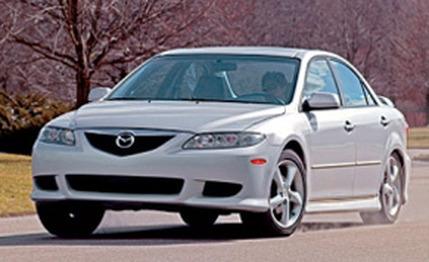
 Long-Term Road Test
Long-Term Road Test
There are about 1.5 million mid-size sedans sold every year in this country. Although most of them are quite capable, they are often unexciting to look at and mediocre performers to boot. So when Mazda announced it was replacing its less-than-thrilling mainstream sedan, the 626, with something more stirring, we felt that the company's "zoom-zoom" advertising might be more than just hype.
The replacement was the Mazda 6, which we previewed and then road-tested in 2002. The sportiness of its tightly stretched skin gave it a muscular look, and its straight-line performance and over-the-road agility were quite impressive—good enough to earn the 6 s a spot on our annual 10Best Cars list for 2003. So the only question that remained was, how would it stack up over the long haul, 40,000 miles' worth?
In early May 2003, we welcomed a shiny new Glacier Silver Metallic Mazda 6 s sedan, the most athletic model in the lineup, to our Hogback headquarters here in Ann Arbor. The 6 s starts at $21,620 with the 220-hp, 3.0-liter DOHC 24-valve V-6, variable intake-valve timing, and a five-speed manual transmission. Being big sports, we opted for the 1SE Sport package, which added 17-inch wheels, husky 215/50R-17 tires, electroluminescent gauges, titanium colored switch panels, fog lights, a rear spoiler, side cladding, "sport type" front and rear bumpers, and oval exhaust tips. A pretty good deal for $860. Living in the refrigerated section of the U.S. as we do, we also bagged the $220 Comfort package, which includes heated seats and exterior mirrors. Leather upholstery was $860, a power sunroof $700, a Bose audio package ran $635, and we had to cough up $450 for the side and curtain airbags and a final 100 bucks for the ULEV option (the Ultra Low-Emission Vehicle standard required in California, New York, Massachusetts, Vermont, and Maine), in which the engine-control computer is recalibrated. The bill came, finally, to $25,445.
Within two weeks of its arrival, we ran the 6 out to the track for its first performance tests. It ripped to 60 mph in a quick 6.4 seconds. It covered the quarter-mile in 15.1 seconds at 93 mph and circled the skidpad at 0.84 g. Stopping from 70 mph required only 178 feet. The last 626ES manual we tested took a leisurely 7.6 seconds to get to 60 mph, covered the quarter in 15.9 seconds at 88 mph, and pulled only 0.79 g on the skidpad. For once, the advertising wasn't sugar-coating the reality: it was zoom-zoom and then some.
Lucky editors and staffers are free to take these long-term cars on extended trips, and we started racking up big odo numbers almost immediately. In rapid fire, the Mazda 6 was in Canada, then Vermont, then Florida, and finally across the country to Arizona to the winter digs of Patrick Bedard. The staff praised the 6's ability to pass easily and its agility in traffic and on twisty roads. Sue Mathews noted, as did many others, that "this car maneuvers in and out of highway traffic flawlessly. Great pick-up speed when you need it as well. Steering very smooth." Although quick at the track and at speed on the highway, some drivers noted the engine's lack of low-end grunt, which made us wonder whether the continuously variable intake-valve timing system was really helping. Wrote one: "Not much happens with this motor until 3500 rpm."
Sprinkled in among all the zoom-zoom praise was a complaint that would be repeated throughout the 6's stay with us, and that was the high level of road noise and tire howling that annoyed almost everyone, enough in some cases to sour otherwise pleasant road trips. Less-aggressive tires and more sound-deadening material would have helped the problem.
Noise aside, the Mazda's catlike reflexes and Velcro grip made it fun to drive. But the ride quality was less than a joy, particularly for rear-seat passengers. The stiff suspension and the low-profile tires turned cracks in the road into canyons; taut handling for the driver turned into a jarring ride for passengers. One of us complained about thin seat padding and a short bench and added, "Spent eight hours in the back seat and found it to cause some sleepy keister spots, although visibility is good."